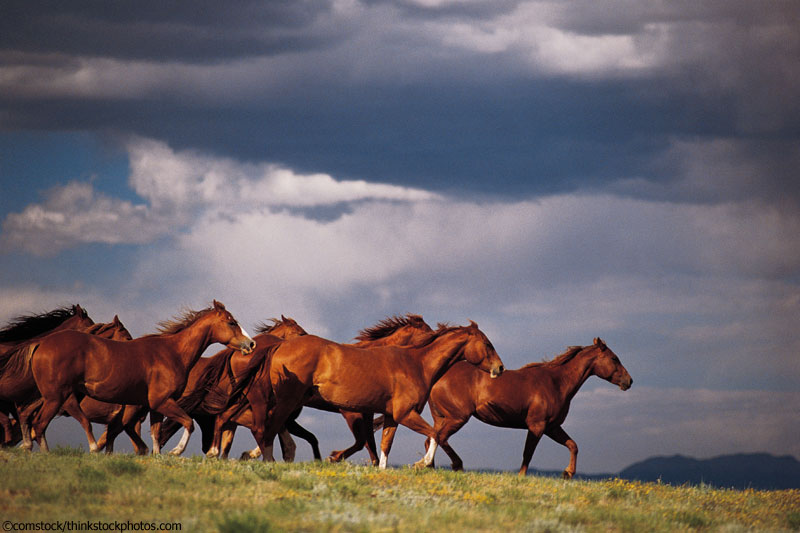Long, hot days are made for spending time at the barn, but they also bring the risk of thunderstorms. While certain regions of the U.S. have a higher risk for severe storms than others, lightning is a threat in every state, and it’s important to know what to do if you’re on the trails or at the barn when a storm hits.

“A lot of lightning safety is just common sense,” says John Bobel, Public Information Officer for the Division of Emergency Management of the Lexington-Fayette Urban County Government in Kentucky. “Take precautions and know what to do during severe weather events.”
Here are 7 ways to stay safe with your horse during a thunderstorm.
- Plan ahead. You probably already do this, but it bears repeating as watching the weather is the best way to avoid the risk of lightning strikes. Check the weather forecast and schedule your barn time to avoid thunderstorm risk.
“Most thunderstorms occur in the afternoon or evening,” says Bobel. “But storms can occur at any time of day.”
- Observe weather changes. Even with all of the weather information at our disposal, the forecast isn’t always going to be accurate, so rely on your own skills of observation. If you hear thunder or see storm clouds ahead, postpone your ride.
“If the skies darken, don’t keep going. Look for shelter,” says Bobel. “The fact is that if you hear thunder, there is going to be lightning. It’s highly unlikely for a situation to exist where there’s thunder and no lightning.”
- Get the warnings. In many tornado-prone areas, sirens are be used to alert people to a storm threat, but don’t rely exclusively on them. If you’re far away from a town or public park, you may not be within earshot of a siren.
“Get a portable NOAA [National Oceanic and Atmospheric Administration] weather radio,” Bobel suggests. “It’s hard to find a spot in the U.S. where there isn’t coverage for the NOAA radio system. Battery operated ones can last for days. You can put them on alert, and if there’s any significant event, the radio will go off and give you some warning.”
There are also smartphone apps that will provide weather alerts, but remember that mobile coverage may be spotty if you’re trail riding out in the wilderness or very rural areas.
- Go indoors, if you can. No outdoor location is safe during a storm. If you’re at the barn, the safest place is in a fully enclosed building with wiring and plumbing, which will conduct the electricity of a lightning strike to the ground.
“Wood structures are safer than metal, and larger is better than smaller,” says Bobel. “Look for a structure that has some sort of lightning protection on it, such as lightning rods.”
Alternatively, you can get inside a vehicle with a metal body and it will protect you from a strike, provided you aren’t touching a conducting path to the outside, such as the keys in the ignition.
- Know your horse. If you’re at home and your horse is used to being outdoors, in most cases you’re better off leaving him turned out than confined to a stall where the thunder could agitate him. Being outdoors in a large, safe pasture will also allow him a better chance of escape if the storm produces tree-downing winds or tornadoes. However, lightning can travel considerable distance along fencing, which can reach animals standing nearby. Horses are also likely to seek shelter under trees, which can be dangerous if their only option is a single tree or trees on high ground. Ideally, you’ll want your pasture to include shelter in a low-lying area, away from water and fences.
If you don’t have a safe turnout area and your horse can be safely confined, keep him indoors with the windows closed until the storm passes.
- Head for the low ground. If you’re miles away from the nearest structure when a storm hits, you can improve your safety by getting to low ground.
“Your best bet is to look for a grove of trees in fairly low ground,” explains Bobel. “Stay away from anything that is high and a singular structure; avoid the single tree that’s on high ground.”
But don’t head for the riverbed. Bobel adds that water is a conductor, so stay away from lakes, ponds and streams during a storm.
- Use the 30-minute rule. Your first instinct might be to get back in the saddle as soon as you think the storm is on its way out, but the risk of lightning doesn’t end when the thunder fades. Wait 30 minutes after you hear the last rumble of thunder before leaving shelter.
Learn more about lightning safety from the NOAA.
Liked this article? Here are more severe weather preparedness resources.
Horse Emergency Resources
Is Your Barn Prepared for Emergencies?
11 Ways to Keep Your Horse Safe in a Natural Disaster
Leslie Potter is the Managing Editor for horseillustrated.com. Follow her on Twitter: @LeslieInLex






Good advise
good advice
Good to remember. Great photo!
I never really thought about staying away from water before! Good to know!
Hope I never need this great info.